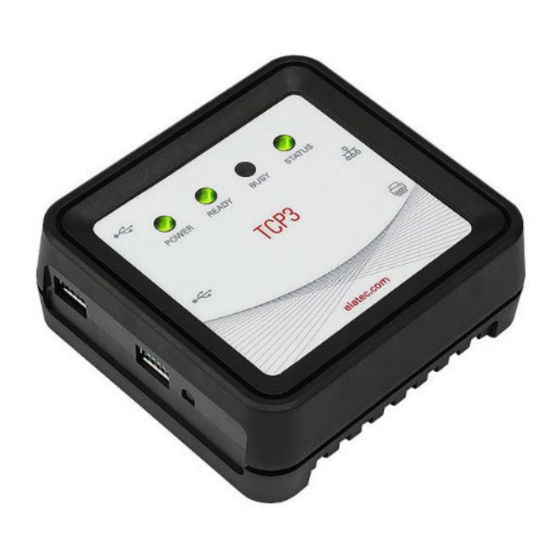
Elatec TCP3 Quick Start Manual
Authentication / release station
Hide thumbs
Also See for TCP3:
- Technical manual (61 pages) ,
- User manual (13 pages) ,
- User manual (14 pages)
Table of Contents
Advertisement
Quick Links
TCP3
AUTHENTICATION / RELEASE STATION
TCP3 enables user authentication and access control security for devices that lack a USB port.
ELATEC's RFID readers enable organizations to extend the use of their employee identification badge to authenticate for applications
beyond physical access. This includes most multi-function printers and some single-function printers. Unfortunately, not all printers
and devices have support for the direct connection of a USB proximity card reader, such as those with no USB port. In these situations,
the ELATEC TCP3 authentication / release station extends ID card-based capabilities such as authentication and pull printing to any
printing device regardless of the manufacturer, make or model.
HOW IT WORKS
TCP3 was designed to minimize information technology
support costs associated with additional IP or MAC addresses
while consuming only one network drop from its Host port.
TCP3 has two Ethernet connectors designated as Host and
Device. The Device port enables connection of a printer or
other peripheral without requiring a second network drop. It is
configurable to behave as a network router where the
converter and connected device consume only one network
address. Much like your home router, anything connected to
the device port gets its own internal IP address and
communicates through TCP3.
TCP3 was designed around ever-increasing network
Performance requirements for high speed graphic printers and
© 2020 – ELATEC GmbH – TCP3 technical description – DocRev1 – 10/2020
From secure printing to kiosks and industrial robotics,
engineering plotters allowing simultaneous communication of
print data and printer status at gigabit speeds. This design also
considers the frequent challenge of finding an open power
source in the often-cluttered print room and is optionally
available with Power over Ethernet as the source of power.
Up to two USB readers can be connected and their data
independently communicated to an authentication server over
Ethernet via UDP or HTTPS using either client or server
communication modes. This is useful in situations where
customers have more than one ID card technology deployed
and need to support a mix of RFID, magnetic stripe or optical
bar-coded cards.
Page 1 of 5
Advertisement
Table of Contents

Summary of Contents for Elatec TCP3
- Page 1 USB proximity card reader, such as those with no USB port. In these situations, the ELATEC TCP3 authentication / release station extends ID card-based capabilities such as authentication and pull printing to any printing device regardless of the manufacturer, make or model.
- Page 2 TCP3 AUTHENTICATION / RELEASE STATION SUPPORTS USB 3.0 & GIGABIT ETHERNET NETWORKS Whichever the application, TCP3 provides unmatched security, performance, device management and flexibility – welcome benefits for any IT network and networked devices. Security Performance Send card data via UDP / SSL / TLS1.2 or HTTP /...
- Page 3 With its feature set developed directly from ELATEC customer input, TCP3 is ready to connect any device, regardless of make or model, onto the network for user authentication and access control. Software Software hooks to use the converter as a print server...
- Page 4 Q: How do I access the TCP3 web page? A: The TCP3 web page is accessed using port 81. HTTP typically uses port 80 but TCP3 redirects all port 80 traffic to the connected printer. To reach the TCP3 web page, simply enter TCP3’s IP address and follow it with colon 81. For example, 192.168.1.20:81.
- Page 5 Website: elatec.com ELATEC reserves the right to change any information or data in this document without prior notice. ELATEC declines all responsibility for the use of this product with any other specification but the one mentioned above. Any additional requirement for a specific customer application has to be validated by the customer himself at his own responsibility. Where application information is given, it is only advisory and does not form part of the specification.















Need help?
Do you have a question about the TCP3 and is the answer not in the manual?
Questions and answers